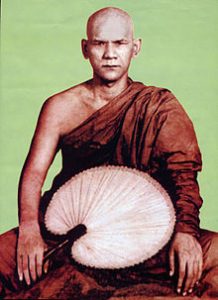五门速行心是如何不生起的(中英对照)
中译 汤华俊
Manual of Vipassana, Vol. I,pt2,p50-54
HOW IMPULSIVE CONSCIOUSNESS OR ILLUMINATION CEASES IN PANCADNĀRA – THE FIVE SENSE-DOORS
Balavavipassakassa sacepi cakkhudvārādīsu ārammane āpāthagate

马哈希尊者
ayoniso āvajjanaṃ uppajjati, voṭṭhabbanaṃ patvā ekaṃ dve vāre āsevanaṃ labhitvā cittaṃ bhavaṅgameva otarati, na rāgādivasena uppajjati, ayaṃ koṭippatto tikkhavipassako, aparassa rāgādivasena ekaṃ vāraṃ javanaṃ javati, javanapariyosāne pana “rāgādivasena evaṃ me javanaṃ javitan “ti āvijjato ārammaṇaṃ pariggahitameva hoti, puna vāraṃ tathā na javati, aparassa ekavāraṃ evaṃ āvajjatopi puna dutiyavāraṃ rāgādivasena javanam javati yeva, dutiyavārāvasāne pana”evam me javanaṃ javatiyeva, dutiyavārāvasāne pana evaṃ me javanaṃ javitanti” āvajjato ārammaṇaṃ pariggahitameva hoti, tatiyavāre tathā na uppajjati. (Ma – ṭha: 2-129)
The gist of the above Pāḷi passage is: In regard to a Vipassanā Yogī who has achieved strong meditation (Balavavipassanā) for having accomplished with Nibbāna-ñāṇa, etc. When visible object, etc, are felt through cakkhudvāra, etc., even if improper thoughts arise in him at the moment of determining consciousness, he would pursue once or twice and then the mind only enters into life-continuum and subsides. No feeling of sensual pleasures would occur. If it so happens, he is deemed to be a quickwitted meditator who has reached the highest. To a mediocre meditator of vipassanā, impulsive consciousness arises once as prompted by rāga, etc. However, when such impulse disappears eventually, since he would bear in mind that “impulsive consciousness as prompted by rāga (lust) has occurred in me”, he puts a check on the impulsive consciousness and continues to contemplate on it. (Although contemplating is made at the end of the impulsive consciousness javana, he has done so only after the lifecontinuum). Again when the second cause of cognitive processes takes place, no consciousness tainted with rāga will occur. In respect however of the inferior type of meditator, although he would contemplate and note only once, when the second course of consciousness arises, consciousness prompted by rāga occurs again. At the end of the second course of cognitive process, he knows and reflects that “the impulsive consciousness has gone and disappeared”, and by contemplating and noting it, he is able to keep control of object. On the third course, the mental impulse tainted with rāga will cease to occur.
Among the three types of individuals mentioned by the said Aṭṭhakathā, the third kind of individual is Mandavipassanā, the second is Majjhimavipassanā, and the first is Tikkhavipassaka. Putting it in another way, the third type of individual is a person who is endowed with the inferior Balava-vipassana, whereas the second and first types of individual are those who are endowed with mediocre and superior kinds of balava (vigorous) vipassana, respectively. Amongst these individuals, as regards mandavipassaka, despite the fact that noting is done by him in respect of kilesa which arises during the cognitive process at the moment of seeing impulsive consciousness associated with defilement occurs again. Thereafter, when consciousness is again noted, and impulsive consciousness, relating to defilements, will cease to occur. Only wholesome consciousness of kusala (meritorious acts), and also Vipassanā will take place. What has happened to the second type of individual in this regard has been already described previously.
As regards the first Tikkhavipassaka, although improper reflective thoughts appear in him when coming into contact with the sense-objects that are likely to evoke the mental defilements, such reflective thoughts would not be strong enough due to the effect of the previous practice of contemplation and noting. Hence, pañca-viññāṇa (five kinds of consciousnesses), sampaṭicchana (recipient consciousness) and santīraṇa (investigating consciousness) cannot take up the sense-object with clarity.Since these thought cannot grasp the sensations clearly, manodvārāvajjana (mind-door adverting consciousness) called vuttho (determining consciousness)being also unable to distinguish and decide whether they are lovable, or hateful, etc., occur two or three times. Referring to the repeated arising of the consciousness which occurs thereafter, depending on the past mental thoughts and their behaviours, it is said to be āsevanaṃ labhitvā, i.e. have obtained the practice or habitude.It is not however intended to imbibe repeated (āsevana paccaya) and its conditionally arisen states.Though it happens thus two or three times, because of its inability to make determination, life continuum arises instead of impulsive consciousness (javana).In the mind-door also, the cognitive process ending with determining consciousness may appear. It would appear as if something is seen with the eye, or the sound is heard, or something is imagined. When it so happens, it might become inconspicuous.When rising from the lifecontinuum (bhavanga), vipassanā consciousness at the minddoor which contemplates and notes the extremely vague act of seeing, might occur. To such a person, there is a cessation of kusala and akusala impulsive consciousness at the five sense doors (pañcadvāra). Only at the mind door, Vipassanā consciousness arises. As mental impulse ceases during the first Vīthi (cognitive process), the object of consciousness becomes very vague and obscure; and in the second cognitive process of mind-door, tatramajjhattupakkhā, which causes equanimity, becomes obvious and then, when Saṅkhārupekkhā-ñāṇa is strengthened and active calm vipassanā-consciousness, i.e., steady contemplating and noting, will take place. When this stage of ñāṇa – insight knowledge – is reached by practising meditation, it will be found conspicuous with one’s own personal knowledge or realization.
五门速行心是如何不生起的
(译自马哈希尊者《观禅手册》第一卷第二册p50-54 ,下面这段巴利文源自《中部》28象迹喻大经义注,而不是摩罗加子经义注)
Balavavipassakassa sacepi cakkhudvārādīsu ārammane āpāthagate ayoniso āvajjanaṃ uppajjati, voṭṭhabbanaṃ patvā ekaṃ dve vāre āsevanaṃ labhitvā cittaṃ bhavaṅgameva otarati, na rāgādivasena uppajjati, ayaṃ koṭippatto tikkhavipassako, aparassa rāgādivasena ekaṃ vāraṃ javanaṃ javati, javanapariyosāne pana “rāgādivasena evaṃ me javanaṃ javitan “ti āvijjato ārammaṇaṃ pariggahitameva hoti, puna vāraṃ tathā na javati, aparassa ekavāraṃ evaṃ āvajjatopi puna dutiyavāraṃ rāgādivasena javanam javati yeva, dutiyavārāvasāne pana”evam me javanaṃ javatiyeva, dutiyavārāvasāne pana evaṃ me javanaṃ javitanti” āvajjato ārammaṇaṃ pariggahitameva hoti, tatiyavāre tathā na uppajjati. (Ma – ṭha: 2-129)
上面这一段巴利文的大意是:就已经获得了强力内观(balavavipassanā)的禅修者来说,因为已经完成了涅槃智等,当眼门所缘等,通过眼识等被感知到,即使不如理作意在确定心的刹那在他心中升起,会继续发生一次或者两次【译注:即确定心总共发生两次或三次】,然后他的心只会沉入有分。 感官快乐的感受不会生起。如果是这样,他就一定是敏锐的禅修者,已达最上。对于中等的禅修者,被欲爱等驱动的速行会生起一次,然而,当这样的速行最终消失后,因为他记忆中知道‘贪爱等驱动的速行心在我内心发生了’, 他会阻止速行心,并继续观照。(尽管是在速行javana结束之后观照,但观照只会在有分之后). 而当第二个认知过程发生时,被欲贪染污的心就不会发生。然而,就缓慢类型的禅修者而言,尽管他会观照且观照一次,当心的第二个认知过程生起时,被欲贪驱动的心再度发生。在第二个认知过程结束时,他知道并意识到‘速行心已去、已消失’。在第三个心路过程,被欲贪染污的速行心会停止发生。
在所提及的义注中所说的三种人中,第三种是缓慢观行者,第二种是中等观行者,第一种是敏锐观行者。换句话说,第三种类型的人是具有较次的强力内观(balava-vipassanā),第二和第一种分别是具有中等强力内观和超强强力内观的人。 在这些人中,就缓慢观行者而言,尽管事实上对烦恼的观照,是在伴随烦恼的看的心路过程的速行心生起的时候进行,当随后心识再度被观照时,和烦恼相应的速行心才会停止发生,只有善的心识,也是内观心识会发生。 第二类人有关情况已经在前面描述。
至于敏锐的观行者,尽管在与可能引发烦恼的感官对象接触时,不如理作意的心可能生起,但由于前面进行观照的效果,这些不如理作意的心不会足够强。 因此,五识、领受心和推度心不能清晰地拾取那个感官对象。由于这些心无法清晰地拾取那个感知,被叫做确定心的意门转向心也不能分别和决定所缘是可爱的还是厌恶的等等,确定心生起两次或三次。 依赖过去意门心和它们的行为随后生发的心,就其重复发生起而言,被称为获得习行(āsevanaṃ labhitvā)。但这并不是把它纳入重复缘(āsevana paccaya) ,它是依因缘生起的状态。 尽管这样发生了两次或者三次,因为它不能作出决定,所以有分心生起而不是速行心生起。 在意门也是如此,以确定心结束的认知过程也可能发生。 如果是这样发生,它可能变得难以觉察,就好像什么东西被眼睛看见,或者声音被听见,或者什么东西被想象。当中断有分流,在意门的内观心识,像观照极不明显的看的行为,可能发生。对像这样的人,就有着五门的善或不善的速行心止息。只有在意门,内观心识生起。因为第一个认知过程的速行心停止,心的所缘变得暗淡不明;在属于第二个认知过程的意门心路过程,引发舍的中舍心变得明显,而那时当行舍智被强化,主动的平静内观心识,也就是平稳的观照,会发生。当通过禅修达到这一阶观智,会以自己个人的智慧或证悟,注意到它是明显的。